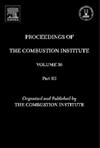DMD analysis on sporadic flame behaviors in low-Lewis-number counterflow under microgravity
Abstract
In order to deepen the understanding on the quasi-steady flame behaviors in counterflow field involving mixtures with low-Lewis number (Le) near lean limit, the experimental and numerical analyses for sporadic flames were carried out. The experiment was conducted with the mixture of Le 0.3 and 0.5 under microgravity environment using parabolic flights of an airplane to eliminate the effect of buoyancy for low-stretch conditions. Three-dimensional numerical simulation with simplified diffusive thermal model was carried out to investigate the three-dimensional structure of sporadic flames. The experimental observations showed the change in the conditions for sporadic flames with changes in Le. The sporadic flames of Le 0.3 could be observed under leaner conditions and endured higher stretch circumstances compared to those observed with Le 0.5. The numerical simulation also reproduced this trend and proved that Le has an important role in the conditions for sporadic flames. To understand the characteristic structure of sporadic flames, the analysis with dynamic mode decomposition (DMD) was conducted. Through this analysis, three characteristic structure modes—planar, radial, and circular—were identified. The decomposed modes showed that the domain of counterflow field could be divided into two; the area forming sporadic flames near the counterflow axis and the area splitting and transporting flame pieces at outer part of the counterflow field. The characteristic length scale was also analyzed using fast Fourier transform (FFT). FFT analysis quantified the characteristic length scale of the decomposed mode of radial and circular. It was also found that the characteristic length scale in radial and angular direction had the same value.

 求助内容:
求助内容: 应助结果提醒方式:
应助结果提醒方式:


